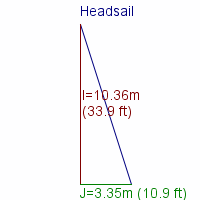Review of Contest 29

Basic specs.

Looking for a new boat? Find a Contest 29 or similar boat for sale
Both the hull and the deck is made of fibreglass. A hull made of fibreglass requires only a minimum of maintenance during the sailing season.
The boat is equipped with 6 berths, a galley and toilet facility.
The interior is like many other boats made of mahogany. Mahogany belongs to the hardwood species, known for being water-repellent and resistant to decay. It has an attractive wood grain and holds wood polish and varnish well.
The Contest 29 is built with a masthead rig. The advantage of a masthead rig is its simplicity and the fact that a given sail area - compared with a fractional rig - can be carried lower and thus with less heeling moment.

Fin keel
The Contest 29 is built with a fin keel. A boat with a fin keel is more manoeuvrable but has less directional stability than a similar boat with a full keel.
The boat can enter even shallow marinas as the draft is just about 1.35 - 1.45 meter (4.43 - 4.73 ft) dependent on the load. See immersion rate below.
Contest 29 may be equipped with an inboard Volvo Penta MD1B diesel engine at 10 hp (7 kW).
Sailing characteristics
This section covers widely used rules of thumb to describe the sailing characteristics. Please note that even though the calculations are correct, the interpretation of the results might not be valid for extreme boats.
The immersion rate is defined as the weight required to sink the boat a certain level.
The immersion rate for Contest 29 is about 164 kg/cm, alternatively 923 lbs/inch.
Meaning: if you load 164 kg cargo on the boat then it will sink 1 cm.
Alternatively, if you load 923 lbs cargo on the boat it will sink 1 inch.
Sailing statistics
This section is statistical comparison with similar boats of the same category. The basis of the following statistical computations is our unique database with more than 26,000 different boat types and 350,000 data points.
What is L/B (Length Beam Ratio)?
The l/b ratio for Contest 29 is 3.25.
What is Relative Speed Performance?
The Relative Speed Performance for Contest 29 is 18
Maintenance
When buying anti-fouling bottom paint, it's nice to know how much to buy.
The surface of the wet bottom is about 23m2 (247 ft2).
Based on this, your favourite maritime shop can tell you the quantity you need.
Note: If you use a paint roller you will need more paint than if you use a paintbrush.
Dimensions of sail for masthead rig.


Are your sails worn out? You might find your next sail here: Sails for Sale
If you need to renew parts of your running rig and is not quite sure of the dimensions, you may find the estimates computed below useful.
| Usage | Length | Diameter | ||
| Mainsail halyard | 23.8 m | (78.0 feet) | 8 mm | (5/16 inch) |
| Jib/genoa halyard | 23.8 m | (78.0 feet) | 8 mm | (5/16 inch) |
| Spinnaker halyard | 23.8 m | (78.0 feet) | 8 mm | (5/16 inch) |
| Jib sheet | 8.9 m | (29.4 feet) | 10 mm | (3/8 inch) |
| Genoa sheet | 8.9 m | (29.4 feet) | 10 mm | (3/8 inch) |
| Mainsheet | 22.4 m | (73.4 feet) | 10 mm | (3/8 inch) |
| Spinnaker sheet | 19.7 m | (64.6 feet) | 10 mm | (3/8 inch) |
| Cunningham | 3.8 m | (12.4 feet) | 8 mm | (5/16 inch) |
| Kickingstrap | 7.6 m | (24.8 feet) | 8 mm | (5/16 inch) |
| Clew-outhaul | 7.6 m | (24.8 feet) | 8 mm | (5/16 inch) |
This section is reserved boat owner's modifications, improvements, etc. Here you might find (or contribute with) inspiration for your boat.
Do you have changes/improvements you would like to share? Upload a photo and describe what you have done.
We are always looking for new photos. If you can contribute with photos for Contest 29 (Essen) it would be a great help.
If you have any comments to the review, improvement suggestions, or the like, feel free to contact us. Criticism helps us to improve.
